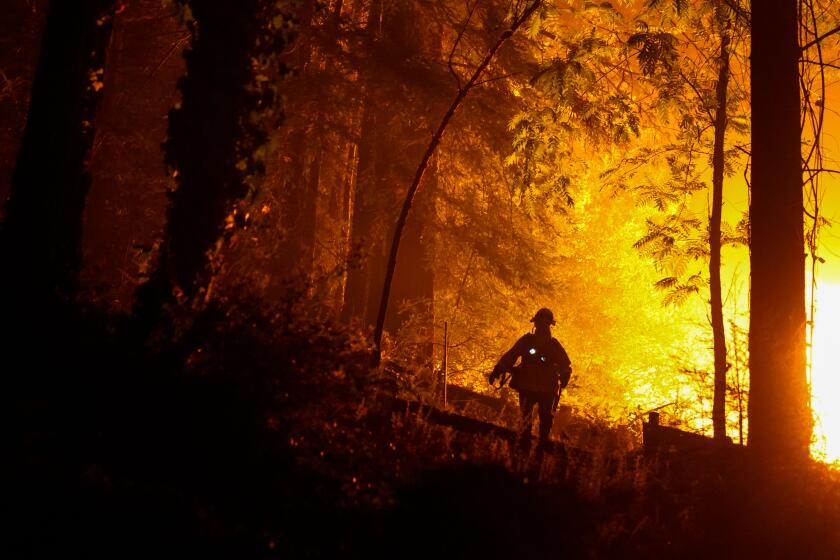What month is this? Strong winds, fires, outages hit Bay Area, knock down PG&E lines

- Share via
MENLO PARK, Calif. — Following an unusually dry November and December, strong winds helped spark numerous wild land blazes in Santa Cruz and San Mateo counties Tuesday, including in areas scorched by last year’s CZU August Lightning Complex fire, according to Cal Fire.
The easterly winds were some of the strongest forecasters had seen for this time of year in the Bay Area and Central Coast. They forced wild land firefighters to scramble at a time of year when their fire services are rarely needed.
“It’s hard to believe this is January,” said Cecile Juliette, a spokeswoman for the California Department of Forestry and Fire Protection’s Santa Cruz unit.
At least two of the blazes, in Boulder Creek and Watsonville, led authorities to initiate evacuations as strong, dry gusts continued into the morning.
Along streets and driveways of the Bay Area peninsula, garbage cans and basketball hoops had toppled over from the gale-force winds, and shed doors appeared blown open, creaking on their hinges, while branches littered sidewalks and paths.
In Sonoma County, one monitoring station recorded a gust of 97 mph, according to the National Weather Service, reminding residents of fire conditions that normally appear in the late summer and fall.
In advance of the winds, PG&E preemptively cut power to thousands of customers in portions of Fresno, Kern, Madera, Mariposa, San Luis Obispo, Santa Barbara and Tulare counties. But power was left on in other wind-hit areas, where power lines were reportedly knocked down. It could not be immediately confirmed whether any of those sparked blazes reported Tuesday.
As of 3 p.m., PG&E reported it had 30,509 customers in the Bay Area without power due to wind-related outages, largely in the South Bay.
John Lindsey, a PG&E meteorologist, tweeted he couldn’t recall “such a powerful easterly event” in his 30 years of forecasting along the Central Coast.
Some of the brush fires burning in Santa Cruz and San Mateo counties were fueled by winds reigniting lingering embers from last summer’s CZU Lightning Complex wildfire, which burned thousands of acres throughout the Santa Cruz Mountains, including Big Basin Redwoods State Park.
Others, however, were probably the result of downed power lines or other factors related to the wind event, said Juliette, the Cal Fire spokeswoman.
Juliette said there are seven sizable fires burning in the region, ranging from five to 40 acres, several of which are only partly or not at all contained. Cal Fire is working with local fire departments, she added, and a strike team from San Luis Obispo is on the scene.
They couldn’t get help from the state. Or the feds. So volunteer firefighters in two Santa Cruz mountain towns tapped an elite network of emergency responders.
While a few storms hit the Bay Area from October through December, the East Bay, San Francisco and San Jose received only about one-quarter of their normal rainfall for that period.
Worldwide, average surface temperatures in 2020 were tied for the warmest on record, according to NASA, and much of Northern California is now experiencing severe or extreme drought.
Winds peaked Monday night and early Tuesday morning, said Ryan Walburn, a meteorologist with the National Weather Service, adding that he had received several reports of dust and ash wafting from last summer’s fire zone. Some were visible via satellite.
Gusts of 80 to 90 mph or higher are possible in some locations
Winds started to die down in the afternoon Tuesday, although red flag warnings will remain for Monterey and San Benito counties until 3 p.m. A wind advisory remains in effect until 6 p.m. for the rest of the Bay Area.
The gusty weather moved southward in the afternoon. “This is becoming more of a Southern California story,” Walburn said.
More to Read
Sign up for Essential California
The most important California stories and recommendations in your inbox every morning.
You may occasionally receive promotional content from the Los Angeles Times.













